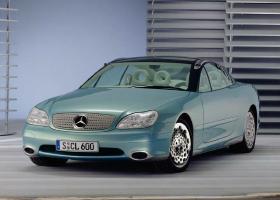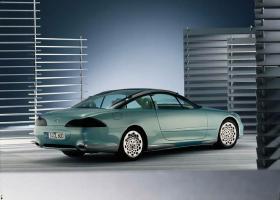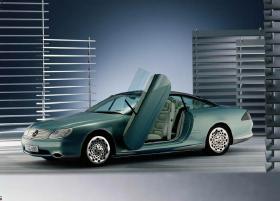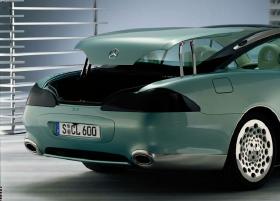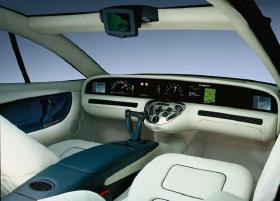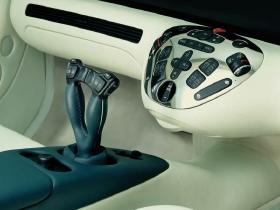Images of a futuristic "new Mercedes-Benz SCL600" automobile — including technical innovations such as a joystick in place of a steering wheel, a video monitor in place of a rear-view mirror, and swiveling gull-wing doors — are genuine photographs of a real car, but that car was constructed as a research vehicle, not as something to be made available for purchase by consumers (although some of its features may have been, or soon may be, incorporated into commercially-available models), and it isn't really "new" (in a technological sense), as it was introduced back in 1996:
The above-displayed photos are pictures of DaimlerChrysler's F 200 Imagination concept study, produced by the Mercedes-Benz design team and unveiled at the Paris Motor Show in 1996 to show off "groundbreaking systems for improving safety and comfort in passenger cars" and demonstrate "just how technical innovations could open up new avenues for the styling of future top-of-the-range cars."
The full DaimlerChrysler press release described the vehicle thusly:
Vehicle: F 200 Imagination
Introduced in: 1996
Where: Paris Motor Show
Goals: Testing of new ergonomics concepts based on drive-by-wire technology; cockpit design
Drive: Four-stroke spark-ignition engine, 12 cylinders, 6.0 liters displacement, 290 kW (394 hp), rear-wheel drive, 5-speed electronically controlled automatic transmission
Technical highlights:
Sidesticks instead of a steering wheel: drive-by-wire
o Forward-looking driving dynamics control
o Active Body Control (ABC)
o Headlight system featuring variable light distribution
o Production launch as bi-xenon headlights with active light system in the Mercedes-Benz E-Class (W 211)
o Video cameras in place of a rearview mirror
o Electro-transparent panoramic glass roof: Production launch in 2002 in the Maybach 62
o Swiveling gullwing doors: Production launch in 2003 in the Mercedes-Benz SLR McLaren
o Voice recognition for mobile phone: Production launch in 1996 under the name LINGUATRONIC in the Mercedes-Benz S-Class (W 140)
Does the car of the future still have a steering wheel and foot-operated controls? The Mercedes-Benz F 200 Imagination, presented at the 1996 Paris Motor Show, serves to test a new ergonomics concept and is the product of the joint efforts of engineers and designers. Sidesticks — little joysticks in the doors and the center console for steering and braking — replace the steering wheel. This is impossible without electronic assistance, and so the technology is called drive-by-wire.
Where until now exclusively mechanical elements have existed which are directly activated by pulses of force emanating from the driver, these are now linked with electric and hydraulic actuators whose desired actions are determined by electronic pulses. If the driver pushes the sidestick forward, the F 200 Imagination accelerates. If he moves the lever to the right or left, the vehicle steers to the right or left. If he pulls the lever back, the vehicle brakes and, if desired, after stopping drives in reverse. To get a little relief the driver can switch the system to the front seat passenger and his sidesticks.
Drive-by-wire is a technical solution entailing consequences — for the interior, for example. If there is no more steering wheel and no more pedals, the passengers have more space and thus more comfort. It also serves safety since the cockpit and the footwell can be designed completely different.
The F 200 Imagination embodies the thoroughgoing networking of electronic systems. One result is its advanced driving dynamics control. The electronics recognize the driver’s commands as requests for a certain driving state — accelerate, brake, steer, reverse — and decide in a flash how to comply with the commands in the best and safest manner. This is situational in nature because the computer utilizes the information of various sensors which tell it the road speed, wheel revolutions, engine revolutions, road condition and body motions. Based on this data, the computer decides, for example, how sharply the wheels should be angled during cornering or what engine speed is appropriate for driving on a wet road.
The system is interlinked with the Active Body Control (ABC). Even when the going gets risky, the electronics keep the car safely on course through lightning-fast intervention in steering, braking, engine or transmission management and chassis control. The driver can fully utilize the technical capabilities of his car without transgressing the physical limits — a genuine advantage for safety. The electronically controlled rear spoiler system of the F 200 Imagination also assists him at this, setting itself upright in a flash and acting as a drag for better deceleration when an emergency braking situation is detected.
The F 200 Imagination research car presents further innovative technology. For example, the headlights featuring variable light distribution: Six individual reflectors in each module, each with a separate bulb, are switched on and off depending on situation and speed in order to provide optimal light for driving at all times without blinding oncoming traffic. In curves, the light follows the wheel angle set by the driver, enhancing safety for night-time driving. At high speeds on superhighways an additional spot reflector is engaged to better illuminate the roadway far ahead. Innovations at the rear end too: the very compact taillight unit incorporates nine separate functions. The inconspicuous turn signal is a slender, arched neon tube distinguished by high luminous power and long life.
Safety is always stressed by Mercedes-Benz, as demonstrated in the F 200 Imagination by the first-ever window airbag, which inflates itself across the side walls and considerably reduces the risk of head injuries in side crashes and rollovers. Since the coupe study does not have a conventional steering wheel, the front airbags are incorporated in a kneepad underneath the dashboard.
Instead of conventional rearview mirrors the experts employ a video system with five permanently installed minicameras. Four of them are discreetly concealed in the roof frame struts on each side of the car and, out on the road, constantly have an eye on the areas next to and behind the F 200 Imagination. The fifth camera is in the rear bumper and automatically switches on when the vehicle backs up. The images appear on various monitors in the vehicle interior where the conventional mirrors otherwise would be located.
In passing, so to speak, the F 200 Imagination also showed what a large, modern coupe might look like — heralding essential design features of the Mercedes-Benz CL which debuted in 1999. The F 200 Imagination has a transparent roof to flood the interior with light. Its special feature: the electro-transparent glass can be darkened at the push of a button to avoid excessive heating of the interior due to strong insulation. The glass has an intermediate layer, a liquid crystal film made of electrically conductive plastic. Electric current causes its crystals to array themselves so that the glass is transparent. In the meantime, this roof can be purchased in a car built by DaimlerChrysler: the Maybach 62.
In the sum of its characteristics, the F 200 Imagination is a pioneering research vehicle, particularly its electronics, which enable new concepts and will play a bigger role in future cars. Of course, they must be subjected to intensive testing before they go into production. The F 200 Imagination played an important part in this and was forerunner of a Mercedes-Benz SL of the R 129 series that was equipped with electronic steering and sidesticks for test purposes in 1998 and thoroughly road-tested.
Some of the findings: steering, braking and accelerating using a sidestick do require one to learn to think differently, but open up new dimensions in respect of driving dynamics, ride comfort and handling safety. The steering ratio and steering forces can be made variable and adapted to the particular situation — differently for parking than for negotiating a fast curve. To brake, the foot no longer has to be moved from the gas pedal to the brake pedal, so that the driver can respond more quickly.
DaimlerChrysler has continued experimenting along these lines with the three-wheeled F 300 Life-Jet, the F 400 Carving two-seater, and the F 500 Mind four-door sedan.
Additional information:
| | More photos of the F 200 Imagination Concept |


